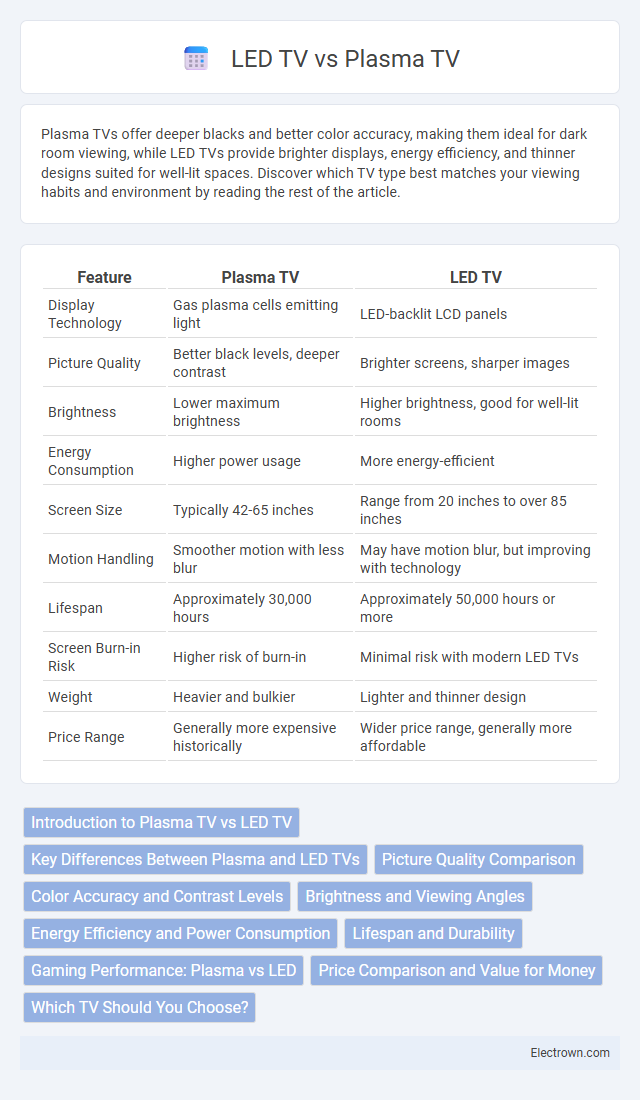Plasma TVs offer deeper blacks and better color accuracy, making them ideal for dark room viewing, while LED TVs provide brighter displays, energy efficiency, and thinner designs suited for well-lit spaces. Discover which TV type best matches your viewing habits and environment by reading the rest of the article.
Table of Comparison
| Feature | Plasma TV | LED TV |
|---|---|---|
| Display Technology | Gas plasma cells emitting light | LED-backlit LCD panels |
| Picture Quality | Better black levels, deeper contrast | Brighter screens, sharper images |
| Brightness | Lower maximum brightness | Higher brightness, good for well-lit rooms |
| Energy Consumption | Higher power usage | More energy-efficient |
| Screen Size | Typically 42-65 inches | Range from 20 inches to over 85 inches |
| Motion Handling | Smoother motion with less blur | May have motion blur, but improving with technology |
| Lifespan | Approximately 30,000 hours | Approximately 50,000 hours or more |
| Screen Burn-in Risk | Higher risk of burn-in | Minimal risk with modern LED TVs |
| Weight | Heavier and bulkier | Lighter and thinner design |
| Price Range | Generally more expensive historically | Wider price range, generally more affordable |
Introduction to Plasma TV vs LED TV
Plasma TVs use gas plasma cells to produce deep blacks and vibrant colors, offering superior contrast for cinematic viewing experiences. LED TVs, a type of LCD TV, utilize LED backlighting, resulting in energy efficiency, slimmer designs, and brighter screens ideal for well-lit rooms. Understanding these key differences helps you choose the right TV technology based on your viewing environment and picture quality preferences.
Key Differences Between Plasma and LED TVs
Plasma TVs utilize gas plasma cells to produce rich colors and deep blacks, resulting in superior contrast and wider viewing angles compared to LED TVs, which rely on light-emitting diodes for backlighting LCD panels. LED TVs offer higher brightness levels, lower power consumption, and slimmer designs, making them more suitable for well-lit rooms and modern aesthetics. Durability and lifespan also differ, with LED TVs typically lasting longer and generating less heat than plasma counterparts.
Picture Quality Comparison
Plasma TVs offer superior contrast ratios and deeper black levels, making them ideal for darker viewing environments and more immersive picture quality. LED TVs, enhanced with advanced backlighting technologies like local dimming, deliver brighter displays and better energy efficiency, which excel in well-lit rooms. Your choice between Plasma and LED TVs should prioritize contrast and black level performance versus brightness and power consumption.
Color Accuracy and Contrast Levels
Plasma TVs offer superior color accuracy and deeper contrast levels due to their ability to produce true blacks and a wider color gamut, making them ideal for watching movies in dark environments. LED TVs use backlighting technology that can result in backlight bleeding, reducing contrast and color precision, although models with local dimming improve these aspects significantly. When evaluating display quality, plasma panels excel in delivering richer, more vibrant colors and more pronounced contrast compared to standard LED screens.
Brightness and Viewing Angles
LED TVs typically offer higher brightness levels, making them ideal for well-lit rooms and vibrant HDR content. Plasma TVs excel in wider viewing angles, maintaining consistent color and contrast even from extreme side positions. Brightness in LED displays can reach up to 1000 nits or more, whereas plasma screens generally peak around 300-500 nits but provide superior uniformity across wide angles.
Energy Efficiency and Power Consumption
LED TVs are significantly more energy-efficient than Plasma TVs, consuming up to 40-50% less power under typical usage conditions. Plasma displays require higher wattage due to their gas discharge technology, often ranging from 150 to 300 watts, whereas LED TVs generally operate between 30 to 100 watts depending on screen size and brightness settings. This lower power consumption translates into reduced electricity costs and environmental impact over the lifespan of LED TVs compared to Plasma models.
Lifespan and Durability
Plasma TVs generally offer a lifespan of around 30,000 to 60,000 hours before noticeable degradation, whereas LED TVs typically last between 50,000 and 100,000 hours, making LEDs more durable over time. Plasma screens can be more susceptible to screen burn-in and image retention, while LED TVs are less prone to these issues, enhancing their long-term usability. When considering your purchase, choosing an LED TV may provide greater longevity and reliability for consistent performance.
Gaming Performance: Plasma vs LED
Plasma TVs offer superior motion handling and faster response times compared to LED TVs, making them ideal for fast-paced gaming with reduced input lag and smoother visuals. LED TVs, especially those with higher refresh rates and gaming-specific modes, provide vibrant colors and energy efficiency but may suffer from motion blur during rapid action scenes. Your choice should consider the importance of motion clarity and input responsiveness to enhance your gaming experience.
Price Comparison and Value for Money
Plasma TVs generally offer better contrast ratios and color accuracy, often priced higher upfront compared to LED TVs, which are more affordable and energy-efficient. LED TVs provide a longer lifespan and slimmer designs, delivering great value for money in everyday use and low maintenance costs. Consumers seeking premium picture quality may consider plasma options worth the investment despite the higher price, while budget-conscious buyers often prefer LED TVs for balancing cost and performance.
Which TV Should You Choose?
Plasma TVs deliver superior color accuracy and deeper blacks, making them ideal for watching movies in dark rooms, while LED TVs offer better energy efficiency, brighter screens, and thinner designs suited for well-lit environments. Your choice should depend on your viewing habits and room lighting, as Plasma excels in dark settings but may suffer from screen burn-in, whereas LED TVs provide longer durability and versatility. Understanding these differences helps you select the perfect TV to enhance your entertainment experience.
Plasma TV vs LED TV Infographic

 electrown.com
electrown.com